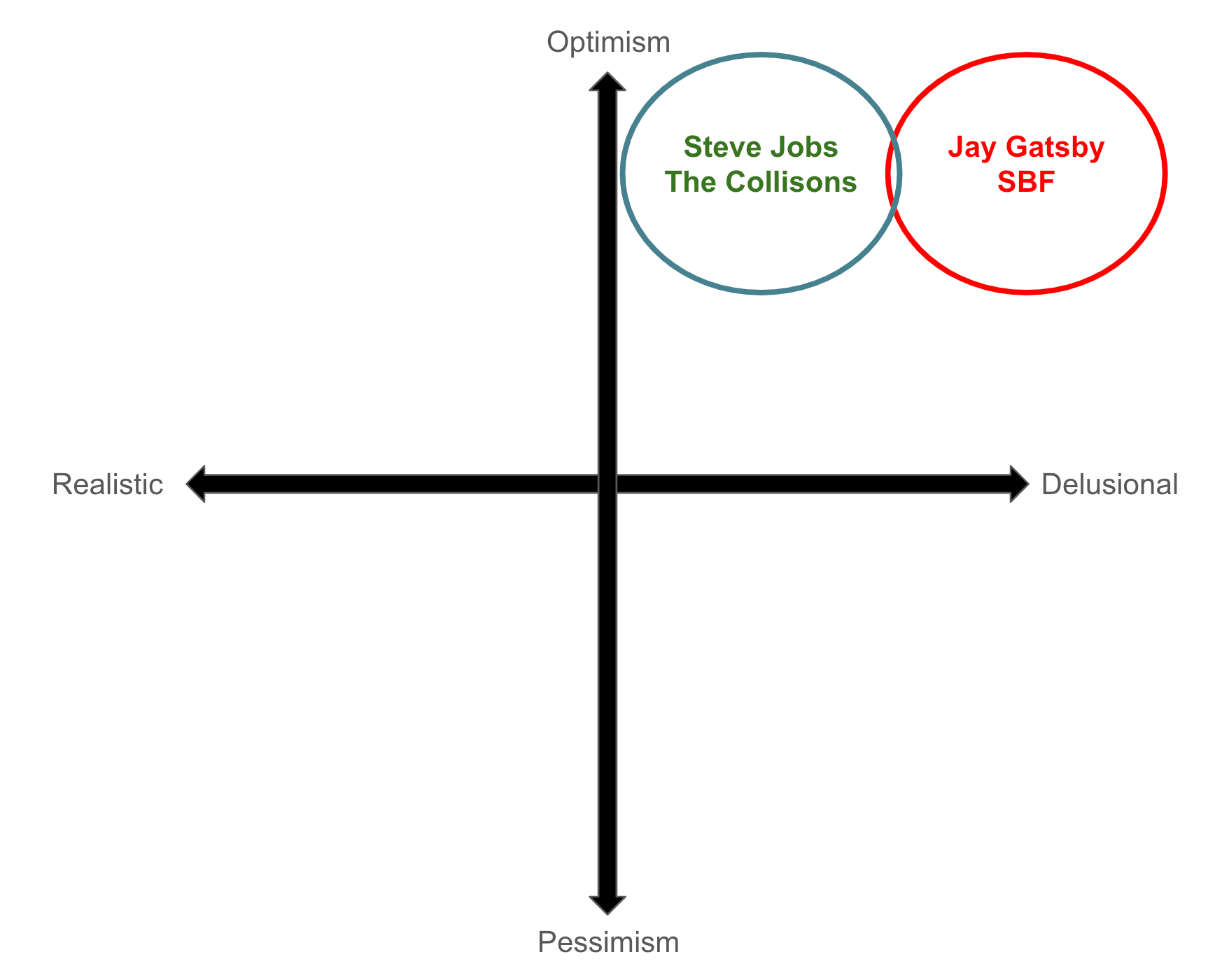

In On Visionary Founders Part I: Would Jay Gatsby be Investable? I asked what we could learn about the archetype of the visionary founder from The Great Gatsby.
The visionary has an uncompromising, fundamentally optimistic vision of a future they want to bring about. They attract others to the project based on force of personality and vision. They are maniacal about the product or service, and unwilling to relent in their pursuit of the vision, inspiring both love and hate.
This archetype describes, at once, the visionary leaders of the most important companies in history AND the most colossal failures. In Part 1, I used the lens of The Great Gatsby to make the case that vision divorced from reality is a tragic flaw that will land a startup in the bottom of the proverbial pool. I presented Sam Bankman-Fried as a cautionary example of a modern day Gatsby–a visionary founder who failed to turn vision into reality.
If SBF is the cautionary tale of a visionary founder divorced from reality, what are the counterexamples that we should aspire to?
In this blog, I revisit the archetype of the visionary founder through the lens of two companies that have had an outsized impact: Apple and Stripe. These two companies have turned powerful visions into even more powerful realities. I will argue that a relentless focus on craft and quality by each of these company’s founders is the key to turning an ambitious vision into a reality.

Steve Jobs once described his purpose at Apple by saying, “We’re here to put a dent in the universe.”
Companies that make a dent in the universe tend to couple vision with a relentless focus on craft and quality.
PodPlay draws inspiration from two in particular: Apple and Stripe.
Apple products (iPad, AppleTV, and Mac Mini) make up the core of the hardware stack for the higher tiers of the PodPlay offering. No company better embodies an integrated approach to hardware and software than Apple. The company’s most iconic product–the iPhone–is the primary digital tool many of us use to manage our physical world.
Stripe is the payment processing layer of the PodPlay platform. Perhaps no company better embodies the idea of software that empowers both the creation of new businesses and allowing existing businesses to do more with less. PodPlay’s popular Coach Connect feature would be impossible without Stripe Connect Platform tooling. And Stripe has allowed us to rapidly go from servicing clients in the United States, to servicing clients in the United Kingdom, Singapore, Malaysia, Australia, France, and Canada, with more countries on the way.
The founders of each company–Steve Jobs and Patrick and John Collison–are visionaries who deeply believe in craftsmanship and quality. That relentless focus on making great products is what turns vision into reality.
Steve Jobs’ mission for Apple was to build insanely great products that are simple to use, easy to understand, and made with great aesthetics. Jobs said Apple was building “tools for the mind that advance humankind.”
Simplicity and great aesthetics are about craftsmanship. Creating insanely great products is about a relentless focus on quality.
As a kid, Steve Jobs learned the value of craftsmanship from his father. “It was important, his father said, to craft the backs of cabinets and fences properly, even though they were hidden. “He loved doing things right. He even cared about the parts you couldn’t see.” [1]
Jobs had an uncompromising vision that was tethered to a relentless focus on quality. In the run up to the launch of the Macintosh, Jobs implored the core team to never compromise. Walter Issacson wrote that, “It was an injunction that would, over time, be both helpful and harmful. Most technology teams made trade-offs. The Mac, on the other hand, would end up being as “insanely great” as Jobs and his acolytes could possibly make it—but it would not ship for another sixteen months, way behind schedule.” When asked about hitting scheduled deadlines to ship the product, Jobs said, “It would be better to miss than to turn out the wrong thing.”
Jobs pushed the Apple team to design products that were simple and aesthetically pleasing. He had a core belief that simple was both beautiful and the result of extraordinary efforts to eliminate unnecessary complexity. Jony Ive, Jobs’ primary design partner at Apple, talked about the hard work required to get to simple: “Simplicity isn’t just a visual style, It’s not just minimalism or the absence of clutter. It involves digging through the depth of complexity….You have to deeply understand the essence of a product in order to be able to get rid of the parts that are not essential.”
It is not an accident that Steve Jobs the visionary is linked in our minds to product demos. In his most famous visionary moment, the unveiling of the iPhone, Jobs was a narrator, while the product was the hero:
PodPlay’s stated mission is to increase the quantum of fun being had in the world. Readers who are familiar with Stripe will find an intentional echo of Stripe’s mission to “increase the GDP of the internet.” Stripe is a business that powers other businesses–a powerful set of digital tools for money movement on the internet. PodPlay is also a business that powers other businesses–a powerful set of digital tools for managing physical spaces.
We believe that adopting two aspects in particular of Stripe’s culture will have a disproportionate impact on making our vision a reality: a focus on craft and a writing culture.
The Collisons argue that craft and beauty are the result of people who care deeply about the product. People like beautiful, well-made things for rational reasons. John Collision said, “What does a beautiful thing tell you? Well, it tells you the person who made it really cared, and you can observe some superficial details, but probably they didn't only care about those and then everything else in a very slapdash way.” [2]
The Collisons believe that craft is likely undervalued because it is hard to quantity. But while it may be difficult to draw a straight line from craft and beauty to profitability, the Collisons argue that a focus on craft is a defensible cultural moat for the business because quality recognizes quality. Patrick Collision says, “the best people consider themselves craftspeople in their domain and they really, above almost all else, want to work with the best other people.”
Stripe is also famously a writing culture. They invest heavily in writing for three reasons [3]:
When asked whether the benefits of a writing culture accrue more to the reader or the writer Patrick Collision said, “There are really considerable benefits on both sides, because for the reader, it's not just that it's maybe more efficient to communicate stuff through text, though in many cases it is, but also there's intertemporal benefit, where future readers can try to understand the through line and the thought process that led us to this point….But it's also true that I and lots of people write things in order to organize one's own thoughts. If that ability was taken away from me, I'd be meaningfully less effective.”
Good writing requires clear thinking. Publishing publicly enforces discipline. Done well, good writing can be a magnet for potential customers, partners, and employees.
PodPlay has an ambitious vision: to increase the quantum of fun being had in the world.
We build technology in service of getting people into physical spaces to engage in fun, healthy, social activities. As we like to say: use your phone to put down your phone. We started with table tennis and today we serve clubs across ping pong, pool, pickleball, padel, soccer, racing simulators, and golf simulators. If an activity requires a reservation and can be augmented with technology, then we can help. Fun is an almost infinite category.
In order to make that vision a reality, we need to attract the right people to our project. People who care deeply about craft, aesthetics, and quality of product. People who write to make themselves clear, to themself and to others. People who believe in the power of building in public.
Apple and Stripe are each massively successful businesses. But we don’t take inspiration from them because of their accomplishments–we take inspiration from them because their core values mirror our own at PodPlay. We believe–as they do–that a focus on craft, aesthetics, quality, and clear thinking is the surest path to making our vision a reality.
[1] All quotes in this section are from Walter Issacson’s biography Steve Jobs
[2] For those interested in learning more about Stripe, I recommend listening to Patrick Collison on Dwarkesh Patel’s podcast: https://www.dwarkeshpatel.com/p/patrick-collison, John Collison on Patrick O’Shaughnessy’s Invest Like the Best podcast: https://www.joincolossus.com/episodes/34646260/collison-growing-the-internet-economy, and the Collison brothers on Invest Like the Best: https://www.joincolossus.com/episodes/85748309/collison-a-business-state-of-mind, and reading Claire Hughes Johnson’s book Scaling People.
[3] From an internal Stripe document reproduced in Scaling People, p. 129
Autonomous experiences have flourished indoors, where we can control for weather, heat, and access. Outdoors–the largest segment of pickleball play–remained unsolved. The result: operators were forced to choose between the flexibility of outdoor courts and the efficiency of automation. Until now. PICKLETILE™ x PodPlay unlocks outdoor autonomous pickleball.
Dec 8, 2025
Originally developed to power PingPod's autonomous table-tennis clubs, PodPlay has quickly expanded to meet demand in pickleball and is now the preferred premium solution for modern, tech-driven venues. We strongly believe that the best software is built with empathy - and the best way for us to build with empathy is to be customers ourselves.
Nov 20, 2025